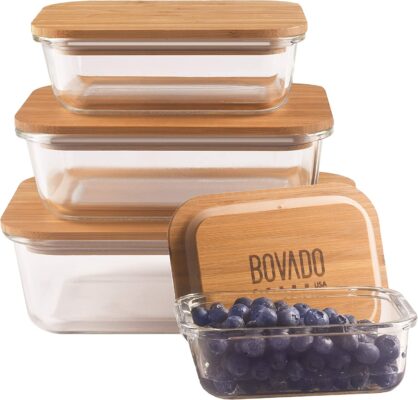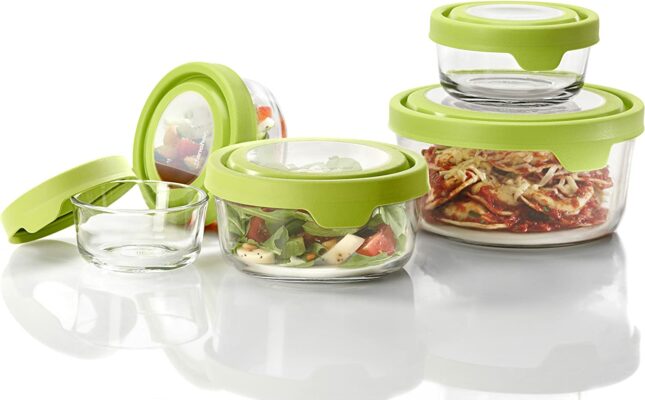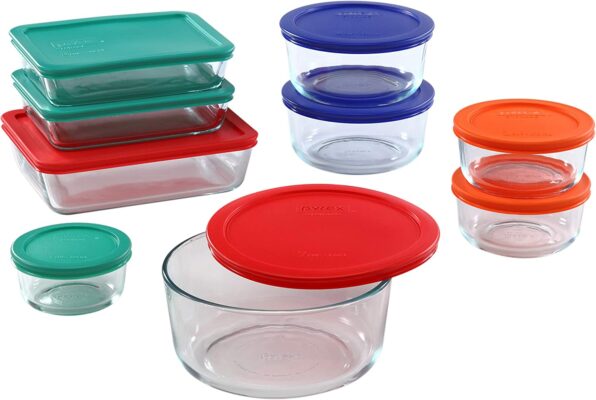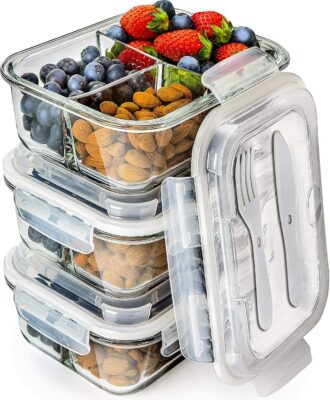In today’s world, people are becoming more and more conscious about their health and well-being. One of the major concerns for many individuals is the safety of the food they consume. Food storage containers play a crucial role in preserving the quality and safety of food.
However, not all food storage containers are created equal, and some can be potentially harmful to your health. This is where non-toxic food storage containers come into play.
One of the primary concerns with traditional food storage containers is the presence of harmful chemicals, such as BPA, phthalates, and PVC, that can leach into food.
These chemicals have been linked to various health problems, such as reproductive and developmental issues, hormonal imbalances, and even cancer.
Non-toxic food storage containers, on the other hand, are made of materials that are safe for food contact and do not contain harmful chemicals. This makes them a great choice for people who are conscious about their health and want their kitchen free from harmful materials.
There are several types of non-toxic food storage containers available in the market, each made of different materials and with unique benefits.
Some of the most common materials used for non-toxic food storage containers include glass, stainless steel, and silicone.
Whether you are looking for convenience, durability, or flexibility, there is a non-toxic food storage container that is perfect for you. So, make the switch today and enjoy the peace of mind that comes with knowing your food is safe and protected.
Understanding Non-Toxic Food Storage Containers
Food storage containers play a crucial role in preserving food’s freshness, flavor, and nutritional value. However, not all food storage containers are created equal.
Non-toxic materials are defined as materials containing no harmful substances or chemicals. These materials are safe for use in food storage containers and do not release harmful chemicals or toxins into the food stored inside.
There are many advantages to using non-toxic food storage containers, and here are a few of the most important:
1. Health Benefits
One of the main benefits of using non-toxic food storage containers is that they do not release harmful chemicals or toxins into the food stored inside. This helps maintain the food’s nutritional value and keeps it safe for consumption.
2. Environmental Benefits
Non-toxic food storage containers are often made from eco-friendly materials that are recyclable and biodegradable. This helps to reduce waste and minimize the environmental impact of food storage containers.
3. Durability
Non-toxic food storage containers are typically made from high-quality, durable materials designed to last. This helps to reduce the need for frequent replacement and reduces waste over time.
4. Safety
Non-toxic food storage containers are designed to be safe for use with food, and they do not pose any risk of harm to the consumer. This provides peace of mind and reassurance that the food stored inside is safe for consumption.
5. Cost-Effective
In many cases, non-toxic food storage containers are more cost effective than traditional containers that are made from plastic or other materials. This is because they are often more durable and do not need to be replaced as frequently.
Whether you are looking for an eco-friendlier option or want to ensure that the food you store is safe for consumption, non-toxic food storage containers are an excellent choice.
The Dangers of Traditional Food Storage Containers
Food storage containers are a staple in every household and are essential for keeping your food fresh and safe for consumption. However, not all food storage containers are created equal, and traditional containers can pose a significant risk to your health and the environment.
Harmful Chemicals in Traditional Containers
Traditional food storage containers are often made from materials that can release harmful chemicals into your food, such as bisphenol A (BPA), phthalates, and polyvinyl chloride (PVC).
These chemicals are known as endocrine disruptors, which can interfere with your hormone levels and increase the risk of health problems such as reproductive disorders, cancers, and developmental problems in children.
Phthalates are a group of chemicals used to soften plastic and are commonly found in food packaging and containers. These chemicals can also leach into food and have been linked to hormonal disruption, congenital disabilities, and other health problems.
Health Risks Associated with Traditional Containers
Not only do traditional food storage containers release harmful chemicals into your food, but they can also leach chemicals into your drinks, primarily when used to store acidic foods and beverages.
This can lead to a range of health problems, including disrupted hormones, increased risk of certain cancers, and developmental problems in children.
Environmental Impact of Traditional Containers
Traditional food storage containers are not only harmful to human health, but they also have a significant impact on the environment.
Plastic containers are often not recyclable and end up in landfills, where they can take hundreds of years to break down. The toxic chemicals in these containers can also leach into the soil and groundwater, contaminating the environment and posing further health risks.
So, next time you are in the market for food storage containers, be sure to choose non-toxic options made from safe, environmentally friendly materials.
Choosing the Right Non-Toxic Food Storage Containers
When it comes to storing your food, you all want safe containers to keep your food fresh.
However, many traditional food storage containers contain harmful chemicals that can leach into your food and threaten your health. That’s why choosing non-toxic food storage containers are crucial.
Here are the factors to consider when choosing non-toxic containers.
Material
The material is one of the most important things to consider when choosing non-toxic food storage containers. Some of the most common non-toxic materials used for food storage include glass, stainless steel, and food-grade silicone.
Each of these materials has its own unique properties and benefits, so it is important to choose a material that meets your specific needs.
BPA-free
BPA (Bisphenol A) is a harmful chemical commonly used to manufacture plastic food storage containers. BPA has been linked to various health problems, including infertility, cancer, and developmental issues in children.
That is why it is important to choose non-toxic containers that are BPA-free.
Microwave Safe
If you are someone who frequently heats food in the microwave, it is important to choose containers that are microwave safe.
Some non-toxic containers may not be safe for use in the microwave, so it is important to check before making a purchase.
Dishwasher Safe
If you want containers that are easy to clean, it’s important to choose dishwasher-safe ones. This will make your life easier and ensure that your containers are properly cleaned every time.
Lids
Another important factor to consider is the lid. It’s important to choose containers with lids that are secure and leak-proof. This will prevent spills and ensure that your food stays fresh.
Size
When choosing non-toxic food storage containers, it’s important to consider the size. You want containers that are big enough to store the amount of food you need but not so big that they take up too much space in your kitchen.
Price
Non-toxic food storage containers can be more expensive than traditional containers, so it’s important to consider your budget when purchasing. However, it’s important to remember that the benefits of non-toxic containers far outweigh the cost.
Top 5 Picks of Non-Toxic Food Storage Containers

Bovado Rectangular Glass Food Storage Containers

Anchor Hocking TrueSeal Glass Food Storage Containers

Pyrex Simply Store Glass Food Storage Containers

PrepNaturals Glass Meal Prep Containers

BKLYN Stainless Steel Food Container
Recommended materials for non-toxic containers
The choice of materials used in food storage containers can significantly affect the food’s safety and health. It is important to choose materials that are non-toxic and do not pose any health or environmental risks.
Some of the most recommended materials for non-toxic food storage containers include:
1. Glass
Glass is a popular choice for food storage containers because it is non-toxic, eco-friendly, and can be used in the microwave and dishwasher. Additionally, glass containers are also free from harmful chemicals such as Bisphenol-A (BPA) and Phthalates, which are commonly found in plastic containers.
Benefits of Using Non-Toxic Glass Containers
Non-Toxic: Unlike plastic containers, glass containers are non-toxic and do not release harmful chemicals into your food or the environment. Glass is a natural material that is 100% recyclable and safe for food storage.
Durability: Glass containers are more durable than plastic and can withstand higher temperatures, making them an excellent choice for hot and cold foods. They are also scratch-resistant, which means they will look good as new even after many years of use.
Versatility: Glass containers are versatile and can be used for a variety of purposes. They are perfect for storing leftovers, packing lunch, or taking food on the go. They can also be used for baking, as they are oven-safe.
Easy to Clean: Glass containers are easy to clean and do not retain food odors or stains. They can be cleaned with soap and water and are dishwasher safe.
Environmentally Friendly: Glass containers are an environmentally friendly choice, as they are reusable and can be recycled indefinitely. Unlike plastic containers, which can take hundreds of years to decompose, glass is infinitely recyclable.
How to Care for Non-Toxic Glass Containers?
Hand Wash: While glass containers are dishwasher safe, it is best to hand wash them to avoid chipping or breaking. Use warm, soapy water and a soft sponge to clean the container, and rinse thoroughly with warm water.
Avoid Extreme Temperatures: Avoid exposing glass containers to extreme temperatures, such as putting a hot container in the freezer or vice versa. This can cause the glass to crack or shatter.
Store Safely: When storing glass containers, make sure to stack them carefully to avoid them falling and breaking. It is also a good idea to store them in a safe place, away from children and pets.
Use with Care: Glass containers are durable but not unbreakable. Avoid dropping them or hitting them against hard surfaces, as this can cause them to break.
Replace Damaged Containers: If a glass container becomes chipped or cracked, it is essential to replace it. Even small chips can cause the glass to weaken and break, which can be dangerous.
2. Stainless Steel
Stainless steel is another popular option for non-toxic food storage containers. It is non-reactive, meaning that it does not leach chemicals into the food. Furthermore, stainless steel containers are durable and easy to clean, making them great for long-term food storage.
Benefits of Using Non-Toxic Stainless-Steel Containers
Non-Toxic: Stainless steel containers are non-toxic and do not leach harmful chemicals into your food, making them a safe option for food storage. Unlike plastic containers, they do not contain BPA, phthalates, or other harmful chemicals.
Durability: Stainless steel is a strong and durable material that can withstand frequent use and is resistant to dents, scratches, and rust. It is also resistant to high temperatures, making it an excellent choice for both hot and cold foods.
Versatility: Stainless steel containers are versatile and can be used for a variety of purposes. They are perfect for storing leftovers, packing lunch, or taking food on the go. They can also be used for cooking, as they are oven-safe.
Environmentally Friendly: Stainless steel is a sustainable material that is infinitely recyclable. It is also more durable than plastic or glass, which means it can last for many years without needing to be replaced.
Easy to Clean: Stainless steel containers are easy to clean and do not retain food odors or stains. They can be cleaned with soap and water and are dishwasher safe.
How to Care for Non-Toxic Stainless-Steel Containers?
Hand Wash: While stainless steel containers are dishwasher safe, it is best to hand wash them to avoid damage or discoloration. Use warm, soapy water and a soft sponge to clean the container, and rinse thoroughly with warm water.
Avoid Extreme Temperatures: Avoid exposing stainless steel containers to extreme temperatures, such as putting a hot container in the freezer or vice versa. This can cause the container to warp or damage the finish.
Store Safely: When storing stainless steel containers, make sure to stack them carefully to avoid them falling and denting. It is also a good idea to store them in a safe place, away from children and pets.
Use with Care: Stainless steel containers are durable but not unbreakable. Avoid dropping them or hitting them against hard surfaces, as this can cause them to dent or become misshapen.
Check for Damage: Regularly check your stainless-steel containers for any signs of damage, such as dents, scratches, or discoloration. If you notice any damage, it is best to replace the container to avoid any potential safety issues.
3. Silicone
Silicone is a flexible and heat-resistant material that is also non-toxic. It is an excellent option for food storage containers because it does not absorb flavors or odors and is also dishwasher-safe.
Food-grade silicone containers are also lightweight and easy to carry, making them ideal for use on the go.
Benefits of Using Non-Toxic Silicone Containers
Non-Toxic: Silicone containers are non-toxic and do not leach harmful chemicals into your food. They do not contain BPA, phthalates, or other harmful chemicals that can leach into your food.
Durability: Silicone is a strong and durable material that can withstand frequent use and is resistant to dents, scratches, and cracks. It is also resistant to high temperatures, making it an excellent choice for both hot and cold foods.
Versatility: Silicone containers are versatile and can be used for a variety of purposes. They are perfect for storing leftovers, packing lunch, or taking food on the go. They can also be used for baking, as they are oven-safe.
Environmentally Friendly: Silicone is a sustainable material that is infinitely recyclable. It is also more durable than plastic or glass, which means it can last many years without needing to be replaced.
Easy to Clean: Silicone containers are easy to clean and do not retain food odors or stains. They can be cleaned with soap and water and are dishwasher safe.
How to Care for Non-Toxic Silicone Containers?
Hand Wash: While silicone containers are dishwasher safe, it is best to hand wash them to avoid damage or discoloration. Use warm, soapy water and a soft sponge to clean the container, and rinse thoroughly with warm water.
Avoid Sharp Objects: Avoid using sharp objects such as knives or scissors on silicone containers, as they can puncture or cut the material.
Store Safely: When storing silicone containers, make sure to stack them carefully to avoid them falling and becoming misshapen. It is also a good idea to store them safely, away from children and pets.
Use with Care: While silicone containers are durable, they are not unbreakable. Avoid dropping them or hitting them against hard surfaces, as this can cause them to become misshapen or punctured.
Check for Damage: Regularly check your silicone containers for any signs of damage, such as punctures or tears. If you notice any damage, it is best to replace the container to avoid any potential safety issues.
4. Ceramic
Ceramic containers are non-toxic and do not react with the food stored in them. They are available in various shapes and sizes, making them suitable for various food storage needs. Ceramic containers are also oven safe and easy to clean, making them an excellent choice for preparing and storing hot meals.
Benefits of Using Non-Toxic Ceramic Containers
Non-Toxic: Ceramic containers are non-toxic and do not leach harmful chemicals into your food. They are made from natural materials and are free from harmful substances like lead and cadmium.
Versatility: Ceramic containers are versatile and can be used for various purposes. They are perfect for storing leftovers, packing lunch, or taking food on the go. They can also be used for baking, as they are oven-safe.
Retains Heat: Ceramic containers retain heat well, which means they can keep food warm for longer periods. This makes them an excellent option for transporting hot dishes or for keeping food warm during a meal.
Aesthetically Pleasing: Ceramic containers are often beautifully designed and can be an attractive addition to any kitchen. They come in a range of colors and designs, so you can choose a style that complements your décor.
Durable: Ceramic containers are durable and can withstand frequent use. They are resistant to scratches and stains and are less likely to break than glass containers.
How to Care for Non-Toxic Ceramic Containers?
Hand Wash: Ceramic containers should be hand washed to avoid damage or discoloration. Use warm, soapy water and a soft sponge to clean the container, and rinse thoroughly with warm water.
Avoid Extreme Temperature Changes: Ceramic containers should be allowed to cool down before being put in the refrigerator or freezer. They should also be brought to room temperature before being placed in the oven.
Avoid Abrasive Cleaners: Avoid using abrasive cleaners or scouring pads on ceramic containers, as they can scratch or damage the surface.
Store Safely: When storing ceramic containers, make sure to stack them carefully to avoid them falling and becoming chipped or broken. It is also a good idea to store them safely, away from children and pets.
Check for Cracks: Regularly check your ceramic containers for any cracks or chips. If you notice any damage, it is best to replace the container to avoid any potential safety issues.
Tips for Maintaining Non-Toxic Containers
Here are some tips for maintaining non-toxic containers, regardless of the material they are made of:
1. Hand Wash
Many non-toxic containers, such as those made from silicone, stainless steel, or ceramic, should be hand washed to avoid damage.
Use warm, soapy water and a soft sponge or cloth to clean the container, and rinse thoroughly with warm water. Avoid using abrasive cleaners or scouring pads, as they can scratch the surface of the container.
2. Avoid Extreme Temperature Changes
Many non-toxic containers are sensitive to extreme temperature changes. For example, stainless steel containers may warp if placed in the freezer, while silicone containers may not perform well if exposed to high temperatures.
Always check the manufacturer’s instructions to determine the temperature range that the container can safely withstand.
3. Store Properly
Store your non-toxic containers in a safe and dry place to avoid damage. Avoid stacking heavy objects on top of them, as this can cause them to become dented or scratched. If the container has a lid, store it separately to avoid losing or damaging it.
4. Check for Wear and Tear
Regularly inspect your non-toxic containers for wear and tear. Look for cracks, chips, or other signs of damage that could compromise the container’s integrity. If you notice any damage, it may be time to replace the container to avoid any potential safety issues.
5. Use Carefully
Always handle your non-toxic containers with care. Avoid dropping them or exposing them to sharp objects that could puncture or scratch the surface. If you plan to use the container to transport liquids, be sure to secure the lid tightly to avoid spills.
6. Avoid Storing Food for Long Periods
While non-toxic containers are generally safe for storing food, it is generally recommended not to store food in containers for extended periods of time. This is especially important for acidic foods with a high oil content, which can cause the container to break down over time.
7. Avoid using harsh chemicals.
Avoid using harsh cleaning agents or chemicals that can damage the container or be harmful to your health. Instead, use natural or gentle cleaning agents such as baking soda, vinegar, and lemon juice to clean your containers.
By following these tips, you can extend the lifespan of your non-toxic storage containers and ensure that they remain safe and effective for storing and transporting your food.
Additionally, be sure to follow the manufacturer’s instructions for each container, as the specific care and maintenance requirements may vary depending on the material used.
Your non-toxic containers can provide years of reliable and safe food storage with proper care and attention.
Are Any Plastic Food Containers Safe?
Plastic food containers are a common choice for storing leftovers, packing lunches, and transporting food. However, there has been growing concern over the safety of plastic food containers and whether they are safe to use.
Here is what you need to know about the safety of plastic food containers.
Firstly, it is important to understand that not all plastic food containers are created equal. Some plastics contain chemicals that can harm human health, while others are considered safe.
One of the main concerns with plastic food containers is the presence of bisphenol A (BPA). BPA is a chemical that is commonly used in the production of polycarbonate plastic, which is often used for food and beverage containers.
Studies have linked BPA to a variety of health concerns, including hormone disruption, obesity, and cancer.
In response to these concerns, many manufacturers have begun to produce BPA-free plastic food containers. These containers are made from alternative materials that do not contain BPA or other harmful chemicals.
However, even BPA-free plastics can potentially contain other chemicals that are harmful to human health. For example, some plastics may contain phthalates, which are used to make the plastic more flexible. Phthalates have been linked to reproductive problems and developmental issues in children.
The good news is that a variety of non-plastic food container options are considered safe for food storage. These include glass, stainless steel, ceramic, and silicone containers. These materials do not contain harmful chemicals and are considered safe for storing food.
It is also important to note that plastic food containers can degrade over time, especially if they are exposed to high temperatures or harsh chemicals. As plastic containers degrade, they can release harmful chemicals into the food.
Therefore, it is a good idea to periodically inspect your plastic food containers for signs of wear and tear and replace any containers showing signs of damage.
Conclusion
In conclusion, there are a variety of safe and non-toxic kitchen appliance options available, including glass, stainless steel, ceramic, silicone, and BPA-free plastic containers. These materials do not contain harmful chemicals and are considered safe for storing food.
When choosing food storage containers, it is essential to consider the potential health and environmental impacts of the materials used. By choosing non-toxic materials, individuals can minimize their exposure to harmful chemicals and reduce their environmental impact.
Overall, using safe and non-toxic food storage containers is important for the health and safety of individuals and the environment. By making informed choices and taking proper care of food storage containers, individuals can help to reduce their exposure to harmful chemicals and promote a safer, healthier future for all.
